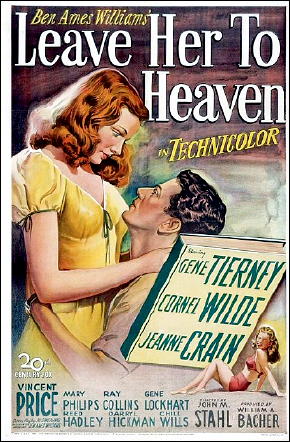May 2010
Monthly Archive
Tue 18 May 2010
A 1001 MIDNIGHTS Review
by Bill Pronzini:
JOSEPH ROSENBERGER – Death Merchant #20: Hell in Hindu Land. Pinnacle, paperback original, 1976.
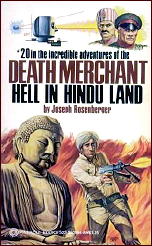
The remarkable success of Don Pendleton’s Executioner series (several million copies sold) naturally spawned the usual bunch of imitators, some of whom enjoyed no small success of their own. The most literate of these is Mike Barry’s Lone Wolf saga; the least literate (and funniest) is Joseph Rosenberger’s ongoing adventures of Richard Camellion (a.k.a. the Death Merchant).
Camellion is a sort of lunatic James Bond in that he is primarily occupied in eradicating threats to the free world arranged by Communist forces or members of a SMERSH-like organization called Spider. He, too, travels all over the world; the main difference between him and Bond is that 007 accomplishes his missions with wit and intelligence as well as violence, while the Death Merchant displays as much wit and intelligence as a “Goju-Ryu karate ball-of-the-foot koga geri groin kick,” which he uses whenever he is engaged in hand-to-hand (or hand-to-foot) combat.
Rosenberger takes the same jovial pleasure in describing breaking bones and teeth (spurting blood, too) as Camellion does in knocking off foreign “boobs.”
There are plenty of broken bones and teeth, and oceans of blood, in Hell in Hindu Land, number twenty in the series. It seems the CIA has been receiving reports that a mysterious secret room in a Buddhist monastery in India contains “secrets from the stars e.g., plans for a “bio-plasm” force that can defy gravity and a “psychotronic generator” that can harness the energy of the human mind — which were allegedly brought to earth by ancient astronauts from another planet.
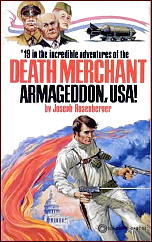
Camellion is dispatched to India to check out this bizarre report and, if there is any truth in it, to gain control of the plans before his old KGB nemesis, Major Kondrashev, can claim them for Mother Russia. All of which is pure nonsense, of course — but no more so than Camellion’s antics on Indian soil, which are principally comprised of feverish battles with the Russians and/or the deadly tribesmen of Rajmahal.
What makes such as this worth reading (marginally so and in small doses) is Rosenberger’s inimitable style. (It has been said that he possesses unappreciated comic talents and that the Death Merchant series is not pastiche but parody; there is no evidence, however, to support such a claim.) The following representative snippet should serve as an indicator of whether or not you would like to become better acquainted with Rosenberger and Camellion:
Vende looked sicker than a Bible salesman on a cheap shot to nowhere when he found himself staring into the big blackness of an Auto Mag muzzle. The Indian’s face twisted like a pretzel! Camellion could see that he was sorting through the mental junk pile of his mind, desperately searching for the right answers.
“Drop the HK and pretend you’re trying to grab a couple of clouds from the sky, ” Camellion said lazily. “NOW!”
Surprise and confusion flickered over the faces of the other men. Dr. Panduhabaya looked as depressed as a sailor who had hoped for love but had been forced to settle for a pint of cheap booze and mechanical sex with a cheap slut.
Other titles in the series include The Albanian Connection (1973), The Mato Grosso Horror (1975), Armageddon, USA! (1976), and Blueprint Invisibility (1980).
———
Reprinted with permission from 1001 Midnights, edited by Bill Pronzini & Marcia Muller and published by The Battered Silicon Dispatch Box, 2007. Copyright © 1986, 2007 by the Pronzini-Muller Family Trust.
Tue 18 May 2010
A 1001 MIDNIGHTS Review
by Bill Crider:
DON PENDLETON – The Executioner: War Against the Mafia!. Pinnacle, paperback original, 1969.
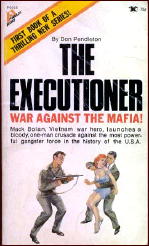
Sergeant Mack Bolan, the ideal sniper in Vietnam, is called home on compassionate leave when his father shoots the other members of the family and then takes his own life. Bolan learns that his father was in debt to a Mafia-controlled loan company and was unable to payoff the debt; as a result, in an attempt to save her father from the loan sharks’ reprisals, Bolan’s young sister, Cindy, had been forced into prostitution.
After burying his family, Bolan decides to get revenge, having been perfectly trained to do so and being psychologically suited for the job. He begins simply, with a .444 Marlin lever-action rifle, but by the end of the book he is using flares and rockets, leveling houses as well as killing men. (The book’s apt subtitle, on the cover though not the title page, is “War Against the Mafia!”)
Before his battle is well begun, Bolan realizes that he does not hate his enemy, that vengeance is not the issue, that there is nothing personal involved. It is simply the good guys against the bad guys, and he is the good guy. He isn’t interested in philosophical discussions of good and evil. The Mafia is the enemy, and he will destroy them or die in the attempt.
When Don Pendleton created the Executioner, he probably didn’t know that he had altered the direction of paperback series fiction. His hero caught the imagination of so many readers that imitations soon flooded the stands (the Butcher, the Marksman, the Sharpshooter, the Assassin, etc.).
But Mack Bolan was the first, and his simple, hard-boiled philosophy was carefully worked out as the books progressed. To read this series is to watch the development of a real American phenomenon.
There have been some fifty books in the series to date, all bearing such titles as Miami Massacre (1970), New Orleans Knockout (1974), and Colorado Kill-Zone (1976).
———
Reprinted with permission from 1001 Midnights, edited by Bill Pronzini & Marcia Muller and published by The Battered Silicon Dispatch Box, 2007. Copyright © 1986, 2007 by the Pronzini-Muller Family Trust.
Mon 17 May 2010
Posted by Steve under
Reviews[16] Comments
LIONEL DERRICK – The Penetrator #10: The Hellbomb Project.
Pinnacle, paperback original; 1st printing, August 1975.
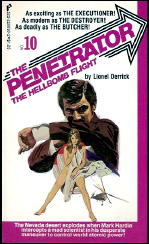
I haven’t double-checked this, but according to one source on the Internet, there were 53 books in this hard-as-nails men’s action-adventure series. While all of them were credited to Lionel Derrick, Mark K. Roberts wrote the odd-numbered entries while Chet Cunningham wrote the even-numbered ones.
Men’s adventure series were extremely popular in the 1970s and on through the 80s. Only the long-running Destroyer and the Executioner are still going today, but I suspect their sales have plummeted badly. I don’t think publishers think men buy men’s action-adventure fiction any more, and they’re probably right. There aren’t any to buy.
In any case, I’ve accumulated several hundred books in this particular genre over years, very few of them new, mostly at library sales or from eBay sellers, if I found them in nice enough condition, and it occurred to me last week that maybe I might try reading one or two of them.
My mistake. I’m sure that The Hellbomb Flight has everything in it that was expected of it, to the person who bought it originally, but the 182 pages of very large print had nothing of interest to me, either major or minor, except possibly very minor, perhaps.
Mark Hardin is the Penetrator, an ex-Vietnam War veteran who’s come home to fight crime and corruption, and working surreptitiously for a bigwig in the Justice Department, it’s usually on a big scale, given Hellbomb Flight as an example. It seems that a former NASA scientist has cracked up big time and intends to take over a Russian communications satellite he suspects of being secretly armed with a payload of hydrogen bombs.
Funny thing is, Dr. Orlando Fitzmuller’s right, but the payload is even more deadly, if that’s possible. What he doesn’t know is that his low budget undercover operation has been infiltrated with Mafia types who intend to use his technical expertise to their own ends.
And that’s it. The whole story right there. There’s a lot of blood that’s shed along the way, but in comparison, Mark Hardin’s love life is rather tame and mild. Lots of arteries blasted away by bullets, skulls split open with the thonk of ripe melons, and rifles and guns and firearms of every shape, make, model and caliber, all lovingly described and I assume correctly, too.
I’ll sell my copy on Amazon. Or at least I’ll offer it for sale there, but I’m afraid there’s going to be a lot of competition.
PostScript. I was wrong. There were only 13 copies offered for sale on Amazon when I went to look, with prices ranging from a penny to ten bucks. The discouraging thing, though, is that the book has no sales ranking, indicating that Amazon has never sold a copy through third party sellers such as myself. Mine’s in Near Fine condition, with remainder lines (I think) across the top edge but otherwise looking unread, even though I’ve obviously read it, but carefully.
I’m offering my copy at $3.45. If and when it sells, I’ll come back with an Update and let you know.
[UPDATE] 05-18-10. I’ve changed my mind. Thanks to everyone who left comments who helped persuade me, and to Bill Crider and Bill Pronzini, whose reviews from 1001 Midnights of three other men’s action-adventure novels I’ve just posted.
What I’ve been convinced of is that there may be some small semi-precious gems stored away in these boxes of paperbacks I have, and if you look at them in just the right way, perhaps even a diamond or two. If Bill Crider can say that the Executioner books marked the beginning of a “real American phenomenon,” then I cannot disagree with him.
Bill Pronzini says there is humor to be found in the Death Merchant books, and from the lengthy quote he provides, I cannot quarrel with that statement either.
And if the Lone Wolf series was written by “‘Mike Barry’ […] a pseudonym of Barry N. Malzberg, a writer of no small talent,” as Bill Pronzini also points out, and that the entire series is “quite remarkable,” and that there is more to the 14 books “than meets the casual eye,” I cannot doubt him at all — all the more so when the very same sentiment has been shared by several of you who have left comments.
So I’m keeping all of the men’s action-adventure books I’ve accumulated over the years, as I say several hundred of them. Alas, I was planning on using that space for something else, or I was hoping to. I’ll reclaim the Penetrator book from Amazon’s listings, and admit defeat. I know when I’m licked. Once I own a book, it is difficult to let go of it, no matter how hard I try!
Mon 17 May 2010
Posted by Steve under
Reviews1 Comment
IT IS PURELY MY OPINION
Reviews by L. J. Roberts
ROBERT B. PARKER – The Godwulf Manuscript. Houghton Mifflin, hardcover, 1973. Reprint paperback: Berkley, 1975. Reprinted many times.
Genre: Private eye. Series character: Spenser, 1st in series. Setting: Boston.

First Sentence: The office of the university president looked like the front parlor of a successful Victorian whorehouse.
Boston PI Spenser (with an “s” like the poet) has been hired by a university president to recover a 14th century illuminated manuscript.
He is directed to a SCARE, the Student committee Against Capitalist Exploitation and Terry Orchard, one of the members, whom he finds along with her aggressive boyfriend, Dennis. Spenser receives a 2 a.m. call and finds Terry drugged. Dennis dead and the evidence of a professional hit.
I’ve not read this book since the 1970s and it is an interesting cultural look back. I am very happy fashions have changed away from white vinyl boots and leisure suits and that technology has advanced from mimeographs and typewriters. But as silly as some of the slang sounds today, at least it wasn’t as profane as today’s speech.
It is also interesting looking at Spenser in his later 30s. He still thought he was funnier than anyone else did. This is a pre-Hawk, pre-Susan Spencer. As annoying as Susan can be, the one thing she did bring to the series was Spenser’s monogamy.
What hasn’t changed is his doggedness, determination to see the case through, dedication to the innocent and his cooking. I am always amazed that he has just the right ingredients in his kitchen to make a wonderful meal.
Those are the little things. What Parker did extremely well was description, dialogue and plot. With a very few words, you knew where you were and the other characters in the scene. He often employed analogies — “The wet wool smelled like a grammar room coatroom.” — which put you right into his scene.
His dialogue, even with the slang of the period, was always tight, crisp and real. As to plot, the story started a bit light and annoying. However, once it took hold, it hit its stride and I was completely engrossed. Re-reading this very first book makes it clear as to why I have read every other book Parker wrote.
Rating: Very Good.
Mon 17 May 2010
REVIEWED BY WALTER ALBERT:
DE LUXE ANNIE. Select Pictures, 1915. Norma Talmadge, Eugene O’Brien, Frank Mills, Edna Hunter, Fred R. Stanton, Joseph Burke, David Burns. Scenario by Paul West, from a play by Edward Clark. Camera: Edward Wynard and Albert Moses. Director: Roland West. Shown at Cinecon 45, Hollywood CA, September 2009.
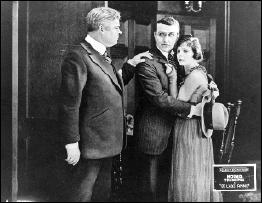
Roland West’s films (among them The Bat, The Bat Whispers, Alibi and The Monster) were often distinguished by fluid, striking camera work, and with only a handful of early silent films to his credit, I was looking forward to this early example of his work. The fact that it starred the beautiful and talented Norma Talmadge was an added incentive to my anticipation.
When Julie Kendal, worried that her husband may be in danger, goes to the apartment where he is lying in wait to to capture De Luxe Annie and her partner, professional con artists, she is surprised by Annie and knocked unconscious. When she wakes up, she has lost her memory and staggers out of the building into a fog, which pretty much describes her state until the end of the film.
The plot is based on what may have been a popular (or just a pulpish) theory of the time: that traumatic events can trigger amnesia. This is not one of Talmadge’s better performances (she seems to have only two expressions, desperation and confusion), but O’Brien, as her partner in her alter ego role as De Luxe Annie 2, proves to be a sympathetic performer, bringing a sense of authentic feeling (he falls for Julie) that is otherwise generally absent from the film.
When Julie is captured, still unrepentant, she undergoes an operation that restores her memory (the audience greeted this with some hilarity) and there’s a fade-out scene in which Jimmy is brought in to meet her, and it’s clear she doesn’t remember him. A disappointing film but still fun to watch as it meanders towards its inevitable conclusion.
Mon 17 May 2010
A 1001 MIDNIGHTS Review
by Bill Pronzini:
H. C. BRANSON – The Pricking Thumb. Simon & Schuster, hardcover, 1942. Paperback reprint: Bestseller Mystery B76, digest-sized, 1946.
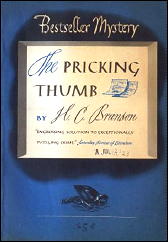
During his Ann Arbor days, Ross Macdonald (Kenneth Millar) was a close friend of H. C. Branson and an admirer of his work. It is easy to see why. Branson wrote literate, meticulously plotted (but flawed) novels in which the emphasis is on deep-seated conflicts that have their roots in the dark past.
Branson’s detective, John Bent, like Macdonald’s Lew Archer, is less a human being than a vehicle around which to build a narrative, a catalyst to mesh all the elements so that each novel’s final statement becomes clear.
In The Pricking Thumb, Bent is hired by an acquaintance, Marina Holland, to investigate the disappearance of her stepson, Bob, and the odd behavior of her husband, Gouvion. But when Bent arrives in the small town of New Paget (in an unnamed state, probably Michigan; a sense of place is almost nonexistent), he finds Gouvion dead of an apparently self-inflicted gunshot wound.
Also found dead this same night are Marina and Gouvion’s doctor, Brian Calvert, under circumstances that suggest the two might have been lovers. It appears to be a case of double homicide perpetrated by Gouvion, who then committed suicide.
But there are too many inconsistencies, leading Bent to believe that it is instead a case of triple homicide. His search for the truth takes him along a tangled trail of relationships, old and new hatreds and jealousies, and not a little double-dealing.
There is a good deal of passion among the characters; unfortunately, there is very little in John Bent or in the writing. Bent is a virtual cipher, about whom we know only that he once practiced medicine. “Someone was feeding [one of my patients] arsenic,” he says to Marina Holland in the first chapter. “The only way I could cure him was to find out who it was and make them stop, which was a little more difficult than it sounds. At any rate, I ended up with a new profession.”
The writing, while well crafted, is so detached and emotionless that the reader tends to lose interest. Had Branson possessed more of Ross Macdonald’s talent, had he been able to make Bent more human and sympathetic, had he injected some passion and vividness into his work, he might have become an important figure in the mystery field. As it is, he is chiefly notable not for his work but for his relationship with Kenneth Millar.
Among his other novels, all featuring John Bent, are I’ll Eat You Last (1941), Case of the Giant Killer (1944), and The Leaden Bubble (1949).
———
Reprinted with permission from 1001 Midnights, edited by Bill Pronzini & Marcia Muller and published by The Battered Silicon Dispatch Box, 2007. Copyright © 1986, 2007 by the Pronzini-Muller Family Trust.
Mon 17 May 2010
A 1001 MIDNIGHTS Review
by Marcia Muller:
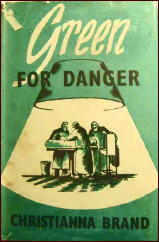
CHRISTIANNA BRAND – Green for Danger. Dodd, Mead, hardcover, 1944. UK edition: John Lane/The Bodley Head, hc, 1945. Reprinted many times in both hardcover and paperback. Film: Individual Pictures, UK, 1946, with Alastair Sim as Inspector Cockrill.
Christianna Brand has written mainstream novels, short stories, and juveniles, but she is best known for her detective novels featuring Inspector Cockrill of the Kent, England, County Police.
Cockrill (known affectionately as Cockie) is a somewhat eccentric, curmudgeonly fellow — less a character than a catalyst in the cases he solves. He delights in setting up situations that force the murderer’s hand, and the murderer’s identity usually seems quite obvious to the reader, until Brand introduces a twist designed to delight.
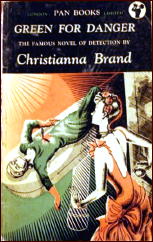
At the beginning of Green for Danger, an unlikely group of characters assemble at a military hospital during the blitz of World War II. Each has his reasons for escaping his previous environment; each has expectations of what this assignment will bring.
What none of them suspects is that a patient — the postman who, incidentally, delivered their letters saying they were coming to Heron’s Park Hospital — will die mysteriously on the operating table, and that all of them will come under Inspector Cockrill’s scrutinizing eye as murder suspects.
The characters are numerous, but Brand nonetheless manages to instill unique qualities that enlist the reader’s sympathy and create dismay at the revelation of the murderer.
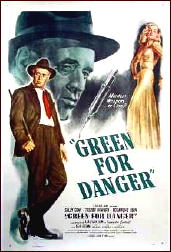
The solution is plausible, the motivation well foreshadowed, and the evocation of both the terror and fortitude of those who endured the German bombing is very real indeed.
Inspector Cockrill has also solved such cases as Heads You Lose (1941), Death of Jezebel (1948), London Particular (1952), and The Three-Cornered Halo (1957).
———
Reprinted with permission from 1001 Midnights, edited by Bill Pronzini & Marcia Muller and published by The Battered Silicon Dispatch Box, 2007. Copyright © 1986, 2007 by the Pronzini-Muller Family Trust.
Previously reviewed on this blog:
Fog of Doubt (London Particular), by Steve Lewis
The Spotted Cat and Other Mysteries, by Mike Tooney
Heads You Lose, by Mike Tooney
Fog of Doubt (London Particular), by Kevin Killian
Sun 16 May 2010
JOYCE HARRINGTON – No One Knows My Name. Avon, paperback reprint, December 1981. Hardcover edition: St. Martin’s, 1980.
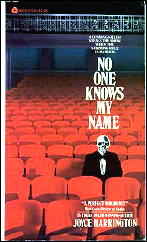
An alternative title might have been Death Comes to Duck Lake, a small former fishing community up near Traverse City, Michigan — my kind of country. I know it well.
On the other hand, I can see where actor- and actressy-types from Hollywood and New York City — whether budding ones or those over the hill — might think of Duck Lake as the ultimate of boondocks. Still, when the repertory company for the hamlet’s summer playhouse makes them the only job offer they can get, somehow it has to start looking not quite so bad, after all.
But one of this year’s company is a compulsive murderer, willing to kill to keep anyone else from the inevitable disappointments that will occur by choosing one of the most fickle careers of them all — show business.
Except for the fact that there is no one here to fill the role of the eccentric detective character, this is truly a classic harkening back to the Golden Age of Mysteries. If there aren’t an overabundance of physical clues, there are lots of hidden secrets and ominous hints and lots of suspects busily mucking up the evidence.
The end, as an aging actor makes a tragically wrong decision, is a deeply chilling one. Indeed, in its way, it’s a completely perfect one.
– From The MYSTERY FANcier, Vol. 6, No. 2, March/April 1982,
slightly revised.
Editorial Comments: It took this review to bring back memories of this fine, well-written novel, but I’ve never completely forgotten it. In terms of a letter grade, I gave this one an “A” at the time.
Joyce Harrington wrote only three novels. This was the first, but she’d been writing short stories for Ellery Queen and others since 1972. Her first story “The Purple Shroud” (EQMM, Sept ’72) won an Edgar, and her shorter works were invariably in the “Best of the Year” annuals from then on through the 1980s.
Sun 16 May 2010
Reviewed by DAVID L. VINEYARD:
LEAVE HER TO HEAVEN. 20th Century-Fox, 1945. Gene Tierney, Cornell Wilde, Jeanne Crain, Vincent Price, Darryl Hickman, Mary Phillips, Ray Collins, Chill Wills, Gene Lockhart. Screenplay by Jo Swerling, based on the novel by Ben Ames Williams. Cinematography: Leon Shamoy. Director: John M. Stahl.
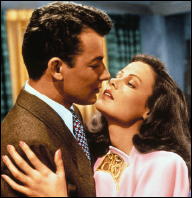
“There’s nothing wrong with Ellen. It’s just that she loves too much.”
I don’t think I have ever heard anyone argue that this stunning Technicolor film — photographed in the glossiest and brightest light imaginable, with sets in New Mexico, Georgia, and Maine that look as if they were straight from the pages of House Beautiful and Architectural Digest — is anything but the darkest of film noir classics.
That’s thanks to a stunning performance by Gene Tierney as a beautiful and soulless sociopath who doesn’t care to share her love — and will go to any length to keep her loved ones to herself — including murder.
Tierney got an Oscar nomination and Leon Shamoy’s cinematography won the statuette for this mix of gothic and soap opera elements with one of the screen’s most beautiful monsters at its heart. ( The title comes from Hamlet, the ghost of Hamlet’s father pleading with his son not to pursue vengeance against his Mother, but rather “leave her to heaven …”)
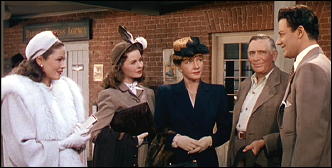
Richard (Cornell Wilde) is a talented artist and writer visiting in New Mexico (and it never looked better) where he meets Ellen (Tierney) who is there to scatter the ashes of her recently dead father. She is the spoiled daughter of her much loved medical researcher father and Mary Phillips, and sister of the adopted Ruth (Jeanne Crain), and brings Richard back to Maine to meet her family.
Richard soon finds himself in Ellen’s determined sights, and it is a delight to be stalked by her, but there are small undercurrents. Ellen’s devotion to her late father is extreme — to the extent her mother adopted Ruth rather than be cut out and alone in the family. Then she breaks up with fiancee Vincent Price in a cold manner so she can have Richard, leaving Price bitter and angry.
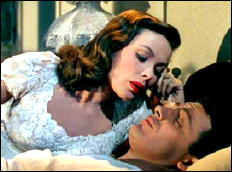
Watching Ellen race her sister across the pool family friend and lawyer Ray Collins observes: “Ellen always wins.” What he doesn’t add is at any price.
But Richard and Ellen marry and seem extremely happy. He brings her back to Warm Springs Georgia with him where he lives with his brother Danny (Darryl Hickman) who has polio. Ellen befriends him and begins to help him recover in the hospital, talking about how he can attend boarding school when he is well, and meanwhile at home she wants no servants around — just she and Richard — maybe a child — in time — a long time.
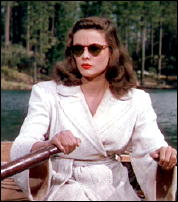
But Ellen’s plans backfire. When she gets Danny well enough to walk he comes with them to Richard’s writing retreat — and even worse the handyman Chill Wills, a friend from Richard’s childhood, makes them a foursome. So something must be done, and since Danny swims every day to strengthen his polio-crippled legs …
The scene where Ellen watches as Danny drowns is one of the finest moments of noir on film, a cold-blooded murder seldom equaled for impact on screen, and done in the brightest of sunshine and the most gorgeous of Technicolor. If ever a film demonstrated noir is a mind set more than a look, it is this one.
But like all Ellen’s plans, this one too backfires. Her family comes to cheer Richard up, with him depressed and lost since Danny’s death — and worst he is withdrawing from Ellen. So Ellen determines to get pregnant to cheer him up — but he loves the coming child too much and grows too close to Ruth. And Ellen can’t face that. She confesses to Ellen she hates the child inside of her.
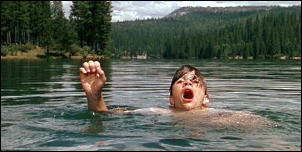
Ellen: “Sometimes the truth is wicked. You’re afraid of the truth aren’t you?”
Ruth: “No, you’re the one who’s afraid.”
Ellen causes herself to lose the child, but by now Richard has begun to see what she is: “He loves me,” she tells Ruth, “but he never liked me.” Eventually he confronts her and she admits she killed Danny and their child — though not quite how fully she was involved. Richard leaves her.
You don’t leave Ellen. She poisons herself and frames her sister for her death, carefully concocting her revenge and framing her sister Ruth. She even asks to be cremated so it will contradict her will that asks to be buried next to her father.
“I’ll never let you go. Never. Never.” she tells Richard with her dying breath.
And the frame takes. The vengeful Price first blames her sister Ruth, as Ellen intended, trying her for murder and putting Richard as much on trial as Ruth.
Price: “You loved her still in June, how about August. Did you still love her in August? … Are you in love with Ruth? Are you in love with Ruth? Are you in love with Ruth?”
Richard sacrifices himself to save Ruth, he confesses that he knew Ellen murdered Danny, and the vengeful Price sees he serves two years for withholding evidence of a crime, but he returns home to Crain’s arms.
Collins: “I guess it’s the only time Ellen didn’t win.”
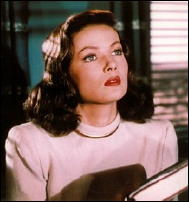
Granted there are some huge holes in logic here. Vincent Price would never have been allowed to prosecute a case he was so close to and Richard could not be charged as an accessory after the fact since he could not testify against Ellen anyway, not to mention Ruth would not have to testify if charged with murder.
But never mind the lapses of logic, this, like much film noir and even many horror films, is a nightmare with its own internal logic. Accept it at that level and it ill hold you with Ellen the most fatale femme of them all.
This film is film noir because of Tierney’s Ellen and only because of Tierney’s Ellen, but in this case that is more than enough.
Ben Ames Williams was a best selling novelist whose work crossed over into numerous genres from historical fiction (All The Brothers Were Valiant) to mystery and suspense. He isn’t read much today, but that isn’t to say he shouldn’t be.
Leave Her to Heaven is a fine example of Hollywood virtues, a product of studio skills and values at their best. Remade for television in 1988 as Too Good To Be True, this may be the darkest foray into bright sunshine you ever experience, a Technicolor nightmare bright and shiny as a polished stone and at its heart as cold and empty.
Gene Tierney was never lovelier on film — and never more monstrous. I don’t know about Dracula and Frankenstein, but Ellen scares me.
Sat 15 May 2010
It’s taken me longer than it should have, but this afternoon I finally finished the formatting of a checklist that should be of interest to everyone who reads and collects mysteries published during the Golden Age of Detection.
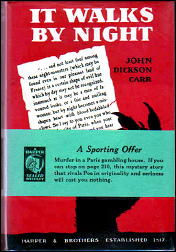
Compiled by Victor Berch, the title is “A Checklist of HARPER’S SEALED MYSTERY SERIES,” and to tempt you even more, here are the first two paragraphs of Victor’s introduction to the list:
Following in the footsteps of Doubleday, Doran & Co.’s entrance into the mystery series with its Crime Club series early in 1928, Harper Brothers introduced in 1929 an unusual concept for its series. Each publication was to have a certain portion of the mystery story sealed off from the reader at a climactic point in the story. If the reader wished to continue to discover the author’s explanation and solution to the committed crime(s), the reader would then have to break the seal and read on.
Should the reader lose interest in the author’s story and returned the book to the bookseller with the seal intact, the reader would be refunded the cost of the book.
This series of books, obviously very collectible today, was published between 1929 and 1934. The most prominent author included in the series was beyond a doubt John Dickson Carr, with nine books in the series (in six years!). It’s the cover of one of these that you see here up above. Other authors include Freeman Wills Crofts, Milton Propper, Mary Plum, Hulbert Footner and Albert Payson Terhune.
Thanks to Bill Pronzini and his collection, covers of some two dozen or more are included. The list is too long to have posted on the blog. You’ll find it instead here on the main Mystery*File website. (Follow the link.)
And just how many of the books were returned to Harper’s for a refund? You’ll have to read Victor’s article.
« Previous Page — Next Page »

















